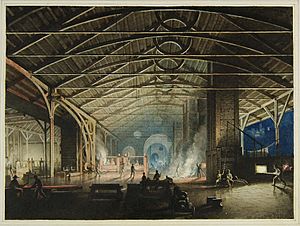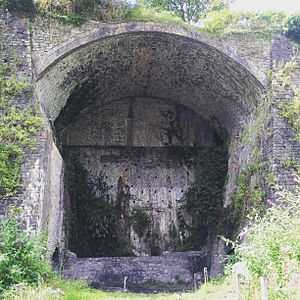Cyfarthfa Ironworks facts for kids
The Cyfarthfa Ironworks was a huge factory in the 1700s and 1800s. It was located in Cyfarthfa, near Merthyr Tydfil, in South West Wales. This ironworks was super important for making iron products that were used all over the world.
Contents
How it All Started
The Cyfarthfa works began in 1765. A businessman named Anthony Bacon leased a large area of land (about 4,000 acres) near the river Taff. He teamed up with William Brownrigg to start the factory. They hired Brownrigg's brother-in-law, Charles Wood, to build a forge. A forge is a place where metal is shaped using heat and hammers.
The factory used water from the river to power its machines, like hammers and mills. In 1766, they started building a large blast furnace. This furnace was 50 feet tall and used coke (a type of fuel made from coal) to melt iron. It was one of the first to use special cast iron cylinders to blow air, instead of old-fashioned bellows.
In 1777, William Brownrigg left the partnership. Around this time, Richard Crawshay became Bacon's partner. They started making cannons for the government. Bacon even built a short canal, called the Cyfarthfa Canal, to bring coal to the ironworks.
In 1782, Anthony Bacon had to stop working on government contracts because he was a Member of Parliament. He passed the gun-making business to Francis Homfray, then to David Tanner. Tanner didn't stay long either, leaving in 1786, the same year Bacon died.
After Bacon's death, there were some legal issues with his business. A court decided that Richard Crawshay should take over the entire works. Crawshay then got a special license to use a new method called "puddling" to make iron better. He built a rolling mill for this process. It took a few years, but by 1791, the new method was working well. In 1890, Crawshay decided to run the works by himself and added even more furnaces.
The Crawshay Family's Big Success
Richard Crawshay's Time (1739–1810)
Under Richard Crawshay, the Cyfarthfa works quickly became a huge producer of iron. Great Britain was involved in many wars around the world, and there was a massive need for cannons and other weapons. The Cyfarthfa works became super important for the war effort. So important, in fact, that Admiral Nelson himself visited the factory in 1802! The Crawshay family even had cannonballs on their family crest to show how vital their ironworks was. Richard later passed the business to his son, William.
William Crawshay II's Era (1788–1867)
William Crawshay II took over managing the works after his grandfather Richard died in 1810. By 1819, the ironworks had grown to six blast furnaces, making 23,000 tons of iron! The factory continued to make high-quality iron, which was needed for the Industrial Revolution. Even the Tsar (ruler) of Russia sent someone to see how they made iron rails. During this time, the Cyfarthfa works faced tough competition from its rival, the Dowlais Ironworks.
William Crawshay II also had a grand home built, which became known as Cyfarthfa Castle. It was built in 1824 and cost a lot of money. The castle was made of strong local stone and designed to look like a "mock castle" with towers and battlements. It was built in Norman and Gothic styles. William Crawshay II and his family lived there. The castle stood, and still stands, in a large park overlooking the ironworks. The Cyfarthfa Canal stopped being used in the late 1830s.
Robert Thompson Crawshay's Challenges (1847–1879)
Robert Thompson Crawshay was the last of the big Crawshay ironmasters. During his time, it became harder for the Cyfarthfa works to compete. Other countries started making iron, and the cost of iron ore (the raw material) went up because local supplies were running out. Robert didn't want to switch to making steel, but in 1875, the works had to close down.
The End of an Era
The Next Generation and Final Closure
After Robert Thompson Crawshay died, his sons reopened the works. But they soon closed again for a long and expensive rebuild to add a steel works. This wasn't finished until 1884. The company, Crawshay Brothers, Cyfarthfa, Limited, kept the business going until 1902. Then, it was sold to Guest Keen and Nettlefolds Limited, who also owned the Dowlais Ironworks.
By 1910, the steelworks had to close again. It briefly reopened in 1915 to help make materials for World War I. But in 1919, the works closed for good. It slowly fell apart until it was taken down in 1928. The closing of the works was a huge blow to the local community, as many people depended on it for their jobs and income.
The Works Today
Even though the Cyfarthfa works closed a long time ago, parts of the huge factory complex are still there today. This includes six of the original blast furnaces. These furnaces are some of the biggest and most complete examples of their kind left anywhere.
In 2013, workers building a new store near the old ironworks site found a big part of the old factory. They discovered a canal, old tram lines, and the plant's coking ovens. Before this discovery, not much was known about how the ironworks prepared its fuel. Archaeologists were able to study these amazing finds before they were reburied.
Today, the site is part of the Cyfarthfa Heritage Area. The local council manages it and has plans to restore parts of the ironworks site. It's a great place to learn about the history of iron making in Wales!





